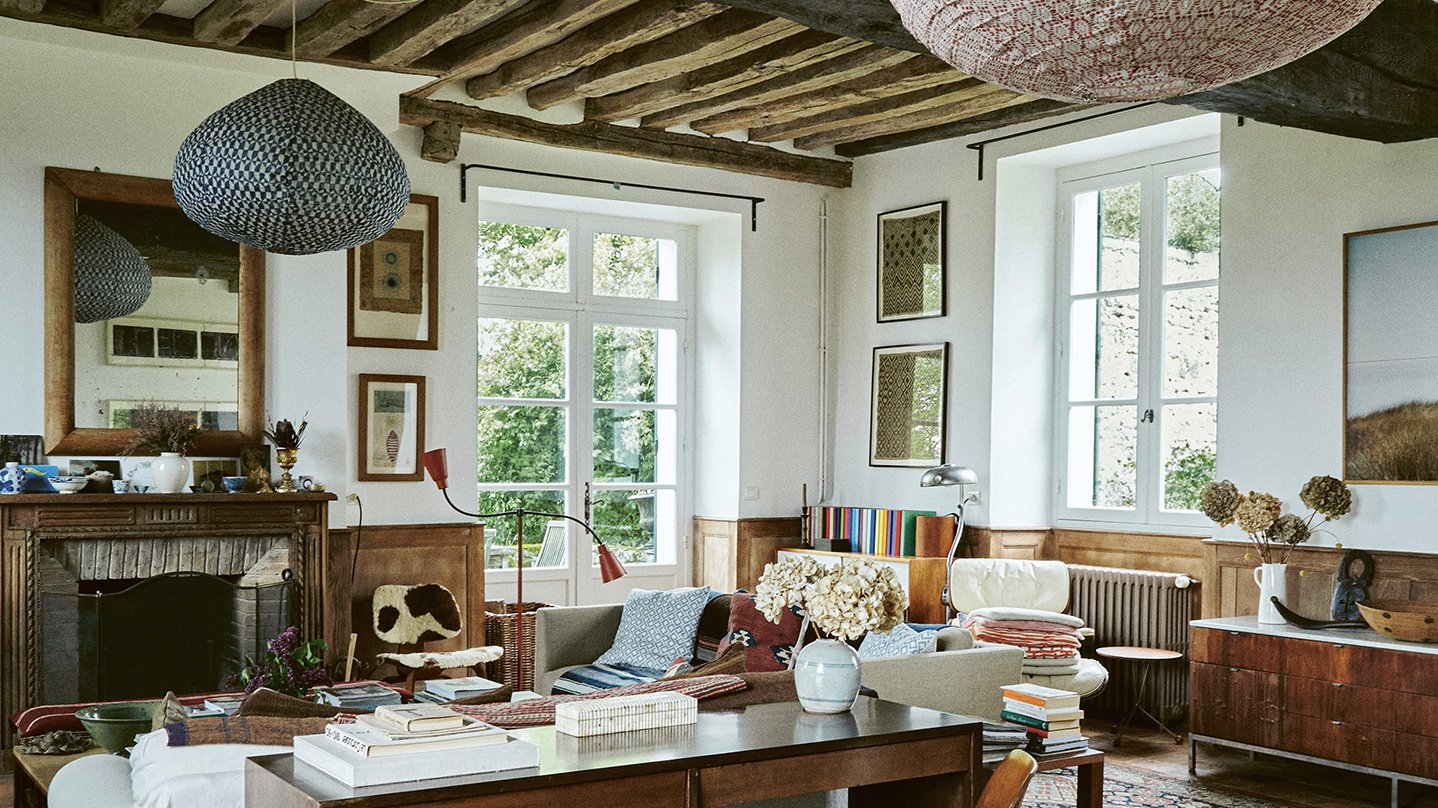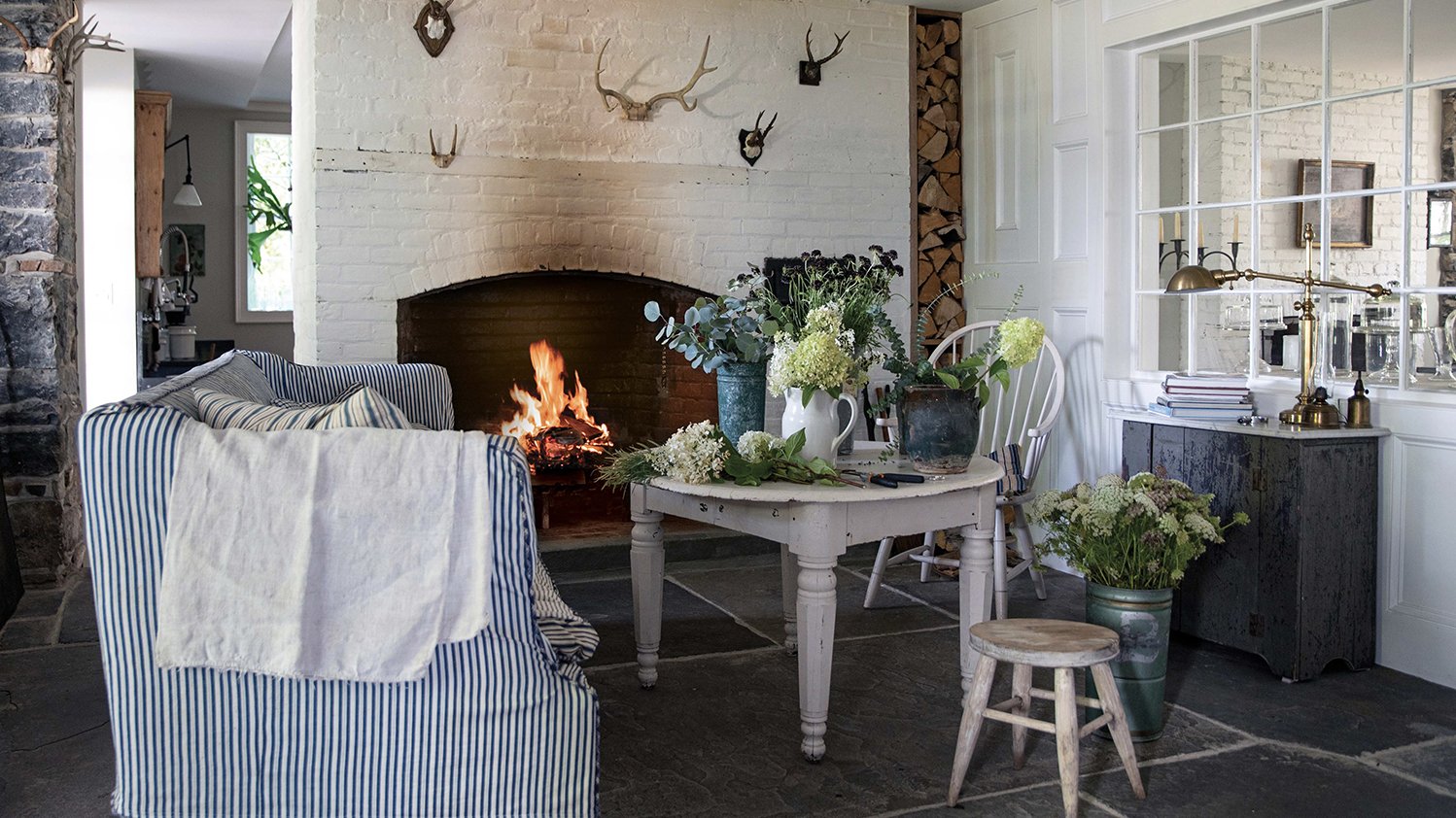Designing for Stability

Nicki Clendening’s living room offers a master class in integrating disparate styling elements to create cohesion and a sense of stability. A weighty, old-world carved armoire adds visual grounding to the space, its rich wood echoed by an African side table in the opposite corner. Lamp bases with seemingly nothing in common are unified by matte black shades. A red frame on a neutral piece of art ties it to the bold crimson tones found in two nearby paintings and the striking beaded pattern of the armchair. Photography excerpted from Spatial Alchemy by Olga Naiman (Artisan Books). Copyright © 2025. Photograph by Lesley Unruh, design by Nicki Clendening.
Written by Olga Naiman | Photography by Annie Schlechter, Lesley Unruh, Max Kim-Bee, Melanie Acevedo, and Reid Rolls.
Our product recommendations include items from our sponsors and/or contain affiliate links, which means we may earn a commission when purchases are made. Rest assured, every item is genuinely chosen by our editorial team.
Interior designer, stylist, and author Olga Naiman believes our homes can do more than just reflect who we are; they can help us become who we want to be. Her new book, Spatial Alchemy: Design Your Home to Transform Your Life, explores how design can serve as a powerful tool for personal growth. In this exclusive piece for Lonny, Naiman shares how thoughtful design can help anchor us during uncertain times, offering simple and meaningful shifts that create stability from the inside out.
Spatial Alchemy: Design Your Home to Transform Your Life by Olga Naiman is a beautifully illustrated guide to harnessing interior design as a tool for personal transformation.
Do you feel unsettled? Do you crave reliability, consistency, stability? When your home feels stable, your psyche is held in place — like a tree anchored by its roots. This sense of grounding fosters self-confidence and self-esteem, because it’s easier to regulate your emotions when you know it’s okay to stay put, to relax, and to sink into a secure base.
I see interior design as a tool for personal transformation. My Spatial Alchemy approach combines science, psychology, spirituality, and design with the goal of creating a home that aligns with what you want to bring forward in your life. And if what you’re seeking is stability, I can help.
I began a nonverbal dialogue with my home: giving away rickety side tables, swapping out bright colors for grounding ones, lowering my bed closer to the floor. My body began to tune into a new bandwidth. The more stable my home became, the more stable my life became — including greater financial stability.
When you design the feeling you want to have into your home, you invite it into your life. My own relationship with stability was a work in progress for much of my adult life. In my twenties, I judged stability as dull. I didn’t appreciate the value of rootedness, choosing instead to live within a creative whirlwind that bordered on chaos. I thought this would make for a free-spirited, exciting life. As I grew older, however, I realized that my nervous system craved constancy — so I started inviting it in.
I began a nonverbal dialogue with my home: giving away rickety side tables, swapping out bright colors for grounding ones, lowering my bed closer to the floor. My body began to tune into a new bandwidth. The more stable my home became, the more stable my life became — including greater financial stability.
how to code more stability into your home:
SEE AND DECODE YOUR PATTERNS
Oftentimes, we design our greatest complaints right into our homes without realizing it. Start by identifying which items in your space feel the least stable. Here are four common patterns I’ve seen in clients' homes that tend to undermine their sense of stability:
Furniture that is broken, damaged, or rickety:
You want to release anything that feels less stable than you want to feel.
Art that’s too small for the wall and appears to float, unanchored:
When larger art isn’t in your budget, hanging textiles (like a tapestry, fabric, or vintage rug) on the wall can ground a room.
An overabundance of skinny-legged furniture:
Take a look at the legs of your furniture. What’s the ratio of skinny to thicker, more solid legs in each room? Aim for a close-to-even balance for visual stability. For example, if your dining chairs have spindly legs, consider pairing them with a more substantial dining table. If your side tables and sofa legs are delicate, a coffee table with a thick pedestal base can help ground the space.
Very Few Pairs of Items:
Having a pair of the same item in a room adds a sense of balance and solidity. An easy way to achieve this is with matching lamps — or even just matching lampshades on different bases.
(Top Left) Thick-legged wooden tables broadcast stability; here, an oversized basket underneath acts as an additional anchor. Photograph by Annie Schlechter, design by Robert Stilin, styling and editing by Doretta Sperduto. (Top Right) This low-to-the-floor bed and solid wardrobe lend gravitas to an otherwise airy, soft bedroom. Photograph by Annie Schlechter, design by Brock Forsblom. (Bottom Left) Notice how the traditional side tables and lamps and heirloom rug help ground the many eclectic elements of this space. Photograph by Reid Rolls, design by Nick Olsen. (Bottom Right) Flanking a curved chest with a pair of matching chairs and symmetrical art telegraphs balance and consistency. Photograph by Melanie Acevedo, design by Elizabeth Mayhew and styling by Carolyn Englefield. Excerpted from Spatial Alchemy by Olga Naiman (Artisan Books). Copyright © 2025.
While most of the decorative elements in this foyer are white, their large-scale, sturdy shapes keep the space from feeling flighty. The console table is covered by a table skirt that hides practical plywood shelves beneath. Excerpted from Spatial Alchemy by Olga Naiman (Artisan Books). Copyright © 2025. Photograph by Max Kim-Bee, design by Dara Caponigro.
When implementing these changes, begin to notice how each one affects your mood and your body. Creating a home that resonates with the safety and stability you desire is one of the biggest self-care moves you can make.
SOLIDIFY YOUR ANCHOR PIECES
Each room in your home has an anchor piece in it, which is usually the largest piece in the room: the bed, the sofa, the dining table. This piece should feel especially stable.
A substantial dining table with solid legs:
Look at your chairs. The more thin legged dining chairs you have, the sturdier your dining table legs should be. Airy-fairy dining tables and chairs do not invite stability to dinner.
A sofa with presence, that you can sink into:
Mid-century modern and very sculptural sofas with no soft arms to sink into look great on instagram, but you sacrifice the feeling of being held, which is deeply supportive.
An upholstered or wood bed with a solid headboard that you can lean into:
Do you see a theme here? If you have no headboard, a scrolly metal headboard, or something that doesn’t feel like it has your back, you are not sleeping in support. If so, adding large Euro square pillows for support may mitigate the problem.
ADD STABILITY ENHANCERS
Invite more stability into your life by choosing earthier, heftier furnishings and accessories: things that feel like you want to feel. There is a fine balance, however. Too many hefty, earthy pieces and the room beings to feel weighed down.
Heavy chests of drawers and armoires:
Choosing a vintage piece will add depth to the room in addition to providing the storage support you need.
Even numbers of artwork hung in a grid:
Pairs of things, by nature, promote stability. An even grid of the same size art promotes structure.
A color palette of deep, saturated tones:
When you're seeking more stability, opt for deeper tones of a color — brick red instead of fire engine red, for example, for the throw on your sofa. You don’t have to go all neutral to create an earthy feel. Rich shades of red, orange, and green can all evoke a grounded, anchored atmosphere.
Other Stability Enhancers include:
Wood with a deep, visible grain, thick pedestals for plants, potted trees, a thick-topped desk with sturdy legs, a freestanding bathtub (I prefer claw-foot tubs for their weight and profile), and rugs large enough to sit under all the furnishings in a room.
Want More of Olga’s Advice?











